Rock festival
A rock festival is a series of musical performances by a variety of artists, which generally take place over a number of days. Some festivals are singular events, while others recur annually in the same location. Occasionally, a festival will focus on a particular genre (e.g., folk, heavy metal, world music), but many attempt to bring together a diverse lineup to showcase a broad array of popular music trends.[1]
History
Initially, some of the earliest rock festivals were built on the foundation of pre-existing jazz and blues festivals, but quickly evolved to reflect the rapidly changing musical tastes of the time. For example, the United Kingdom's National Jazz Festival was launched in Richmond from August 26–27, 1961. The first three of these annual outdoor festivals featured only jazz music, but by the fourth "Jazz & Blues Festival" in 1964, a shift had begun that incorporated some blues and pop artists into the lineup. In 1965, for the first time the event included more blues, pop and rock acts than jazz, and by 1966, when the event moved to the town of Windsor, the rock and pop acts clearly dominated the jazz artists.[2]
A similar, though more rapid, evolution occurred with Jazz Bilzen, a solely jazz festival that was inaugurated in 1965 in the Belgian city of Bilzen. The 1966 festival still featured mostly jazz acts. However, by the time of the third festival from August 25–27, 1967, rock and pop acts had edged out most of the jazz bands and become the main attraction.[3]
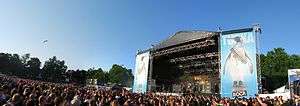
In the United States, rock festivals seemed to spring up with a more self-defined musical identity. Preceded by several precursor events in the San Francisco area, the first two rock festivals in the US were staged in northern California on consecutive weekends in the summer of 1967: the KFRC Fantasy Fair & Magic Mountain Music Festival on Mount Tamalpais (June 10–11) and the Monterey International Pop Festival (June 16–17).[4][5][6]
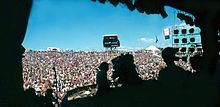
The concept caught fire and spread quickly as rock festivals took on a unique identity and attracted significant media attention around the world. By 1969, promoters were staging dozens of them. According to Bill Mankin, in their dawning age rock festivals were important socio-cultural milestones: "… it would not be an exaggeration to say that, over a few short years, rock festivals played a unique, significant – and underappreciated – role in fueling the countercultural shift that swept not only America but many other countries [during the 1960s]. It seems fitting… that one of the most enduring labels for the entire generation of that era was derived from a rock festival: the ‘Woodstock Generation’."[7]
Reflecting their musical diversity and the then-common term ‘pop music’, for the first few years, particularly in the US, many rock festivals were called ‘pop festivals’. This also served to distinguish them among the ticket-buying public from other, pre-existing types of music festivals such as jazz and folk festivals. By the end of 1972, the term ‘pop festival’ had virtually disappeared as festival promoters adopted more creative, unique and location-specific names to identify and advertise their events. While it was still in vogue, however, over-zealous promoters eager to capitalize on the festival concept made the most of it, with some using the term "Pop Festival" or "Rock Festival" to advertise events held on a single day or evening, often indoors, and featuring only a handful of acts.[8]
Today, rock festivals are usually open-air concerts spread out over two or more days and many of the annual events are sponsored by the same organization.[9]
Features
Production and financing
Several of the early rock festival organizers of the 1960s such as Chet Helms, Tom Rounds, Alex Cooley and Michael Lang helped create the blueprint for large-scale rock festivals in the United States, as well promoters such as Wally Hope in the United Kingdom. In various countries, the organizers of rock festivals have faced legal action from authorities, in part because such festivals have attracted large counterculture elements. In 1972, Mar Y Sol Pop Festival in Manatí, Puerto Rico attracted an estimated 30–35,000 people, and an arrest warrant was issued for promoter Alex Cooley, who avoided arrest by leaving the island before the festival was over.[10] British Free Festival organizers Ubi Dwyer and Sid Rawle were imprisoned for attempting to promote a 1975 Windsor Festival,[11][12][13][14] and the British police would later outright attack free festival attendees at the 1985 Battle of the Beanfield.
Festivals may require millions of USD to be organized, with the money often gathered through fundraising and angel investors.[15][16]
Stages and sound systems
While rock concerts typically feature a small lineup of rock bands playing a single stage, rock festivals often grow large enough to require several stages or venues with live bands playing concurrently. Some of these stages may in turn become known and large enough to be seen as festivals themselves, such as The Glade at the famous Glastonbury Festival in England. As rock music has increasingly been fused with other genres, sometimes stages will be devoted to a specific genre, such as folk rock or reggae. Some festivals such as SXSW hold smaller concurrent concerts throughout a city.
Advances in sound reinforcement systems beginning in the 1960s enabled larger and larger rock festival audiences to hear the performers' music with much better clarity and volume. The best example was the pioneering work of Bill Hanley, known as the "father of festival sound", who provided the sound systems for numerous rock festivals including Woodstock. Other examples included the Wall of Sound invented in the 1970s to allow the Grateful Dead to play to larger audiences, and mobile sound systems such as those maintained by the Merry Pranksters, which would later be important in the development of events such as reggae festivals and raves.
Camping and crowd control
Many festivals offer camping, either because lodging in the area is insufficient to support the crowd, or to allow easy multi-day access to the festival's features. Festival planning and logistics are frequently a focus of the media, and while some festivals such as the historic Sky River Rock Festival were seen as logistical successes, other festivals such as the heavily commercialized Woodstock 1999 were crowd control disasters, with insufficient water and other resources provided to audiences. Many early rock festivals successfully relied on volunteers for crowd control, for example individuals like Wavy Gravy and biker groups such as the Hells Angels[17] and Grim Reapers Motorcycle Club.[18] Gravy in particular called his security group the "Please Force," a reference to their non-intrusive tactics at keeping order, e.g., "Please don't do that, please do this instead". When asked by the press — who were the first to inform him that he and the rest of his commune were handling security — what kind of tools he intended to use to maintain order at Woodstock in 1969, his response was "Cream pies and seltzer bottles."[17] Other rock festivals hire private security or local police departments for crowd control, with varying degrees of success.[19]
Historic rock festivals
1950s–1960s
| Name | Years | Location | Notes | |
|---|---|---|---|---|
| Historic jazz festivals | 1950s–1960s | (many) | US/Europe | Some early jazz festivals and blues festivals were showcases for rock and roll artists, primarily in the US and the UK |
| Swamp Pop Music Festival | 1950s–1960s | Louisiana | "Swamp pop" is a distinctive style of music that began in the 1950s when Louisiana teenagers first heard new rock-n-roll idols like Chuck Berry, Bo Diddley and Fats Domino on the radio. The Festival's most popular period was between 1958 and 1964, when nearly two dozen swamp pop recordings reached the national charts.[20] | |
| Newport Jazz Festival | 1954–present | Newport, Rhode Island | It was established in 1954 by socialite Elaine Lorillard. While initially focused on acoustic jazz, the festival's 1969 program was an experiment in fusing jazz, soul and rock music and audiences. | |
| Beaulieu Jazz Festival | 1956–1961 | Beaulieu, Hampshire | Lord Montagu of Beaulieu holds an annual traditional and modern jazz festival in the ground of Beaulieu estate, in the New Forest. Attracts beats and jazz eccentrics, called 'ravers', and both pop and jazz music.[21] | |
| National Jazz and Blues Festival |
1961–1980s | United Kingdom | Though dedicated mostly to jazz and blues in the beginning, this annual festival has become a showcase for progressive rock as well, featuring groups such as the psychedelic rock group Cream. | |
Reading and Leeds Festivals.jpg) |
1961–present | England | The line-up settled into a pattern of progressive rock, blues and hard rock during the early and mid 1970s[22] then became the first music festival to embrace punk rock and new wave in the late 1970s.[23] | |
| Festival Omladina |
|
Subotica, Serbia (Yugoslavia 1961– '90) | Established in Subotica in 1961, Festival Omladina (Youth Festival) was originally a competition of young composers of popular music. Their compositions were initially performed by pop singers, but soon the performers of competing compositions became rock bands. In 1970s, the non-competitive part, featuring established rock acts, was added to the program, and in the 1980s the festival became a competition of young rock bands. During the years, some of the most notable acts of the Yugoslav pop and rock scene performed on the festival.[24] | |
| Parada ritma / Vatromet ritma | 1964–1965 | Yugoslavia | Parada ritma (Parade of Rhythm) / Vatromet ritma (Fireworks of Rhythm) was a series of concerts featuring Yugoslav rock bands, held in Belgrade and Novi Sad during 1964 and 1965. The first edition is considered the first rock festival in Yugoslavia and arguably the first rock festival in a communist country.[24][25] | |
| Vilar de Mouros Festival |
|
Portugal | Usually recognized in Portugal as the precursor of all the music festivals, the Vilar de Mouros Festival became a cultural icon, counting with the first edition in 1965. In that year it was organized a folk festival that by the large impact it had, reached immortalization in 1971, most of all because of rock music nature and the presence of bands with great international projection. Held with long interregnums and therefore named as the festival of several generations, it has been creating a certain eclecticism, which attracts musical styles that lead people with the most different musical tastes. | |
Jazz Bilzen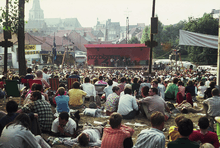 |
1965–1981 | Bilzen, Belgium | First festival on the continent where jazz and pop music were brought together. Sometimes called the "mother of all (European) festivals," Bilzen started out jazz, but soon blues, folk, rock and soul, later even punk and new wave, came to be incorporated as well. | |
| Gitarijada (Belgrade) |
1966–1967 | Belgrade, Yugoslavia | Gitarijada (Guitar Fest) was a festival held in Belgrade, featuring performances of Yugoslav rock bands. The festival was one of early rock festivals in Yugoslavia and considered one of the milestones in the history of Yugoslav rock music.[26][27][28][29] The first edition of the festival was attended by more than 15,000[28] and the second by more than 13,000 spectators.[30] | |
| Gitarijada (Zaječar) | 1966–present | Zaječar, Serbia (Yugoslavia 1966— '91) | Established in Zaječar in 1966, Gitarijada (Guitar Fest) is one of the longest lasting festivals in Serbia and in South Eastern Europe and the largest festival of young and unaffirmed bands in South Eastern Europe.[31] Currently, it consists of competitive part and of non-competitive part featuring well-known Serbian and foreign acts. | |
| Trips Festival | 1966 | San Francisco, California | The Trips Festival on January 21–23, 1966 was the most attended and advertised of the early Acid Tests events, which were started in late 1965.[32] Ten thousand people attended this sold-out event, with a thousand more turned away each night.[33] On Saturday January 22, Grateful Dead and Big Brother and the Holding Company came on stage, and 6,000 people arrived to imbibe punch spiked with LSD and to witness one of the first fully developed light shows of the era.[34] Grateful Dead sound engineer Ken Babbs notably created a new sound system for the festival, building sound amplifiers that didn't distort when turned up to high sound levels. The Trips Festival was followed by the October 6, 1966 Love Pageant Rally, held in San Francisco to protest the banning of LSD. | |
| Mantra-Rock Dance | 1967 | California | Occurring several weeks after the Human Be-In event on January 14, 1967, the January 29 Mantra-Rock Dance was a precursor event to the large outdoor festivals that debuted in the summer of 1967. The dance was held in San Francisco's Avalon Ballroom, featured three bands including Grateful Dead, and was organized by followers of the International Society for Krishna Consciousness to introduce its founder to a wider American audience. | |
| Fantasy Fair and Magic Mountain Music Festival 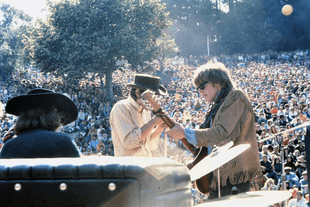 |
1967 | Marin County, California | Over 36,000 people attended the two-day concert and fair on June 10 and 11th, that was the first of a series of San Francisco area cultural events known as the Summer of Love. Influenced by the popular Renaissance Pleasure Faire, which was founded in Irwindale, California in 1963 as the first large renaissance fair. Fantasy Fair became a prototype for large scale multi-act outdoor rock music events now known as rock festivals. | |
| Monterey Pop Festival | 1967 | Monterey, California | Major one-time cultural event on June 16–18, with genres including rock, pop and folk, including blues-rock, folk rock, hard rock and psychedelic rock styles. | |
| Schaefer Music Festival | 1967–1976 | New York City | First held in the summer of 1966 in Central Park as the small event the Rheingold Central Park Music Festival, the first lineup in July 1967 with the new name included only The Young Rascals; The Jimi Hendrix Experience; and Len Chandler. The lineup afterwards grew exponentially, with diverse genres related to blues and pop. On 21 July 1969 Led Zeppelin were the headliners of the Schaefer Music Festival at New York City's Wollman Rink, along with B.B. King.[35] | |
| 1968 Pop & Underground Festival | 1968 | Hallandale, Florida | An estimated 25,000 people attended the May event, which was promoted by Richard O'Barry and Michael Lang, later famous as promoter of Woodstock. This event would later come to be known colloquially as the "Miami Pop Festival", though it was unrelated to the December 1968 "Miami Pop Festival". | |
| Northern California Folk Rock Festival I | 1968 | San Jose, California | May 18–19, 1968. The first festival featured notable bands such as Jefferson Airplane, The Doors, Janis Joplin, The Youngbloods, The Electric Flag, Kaleidoscope, Taj Mahal, etc. | |
Summerfest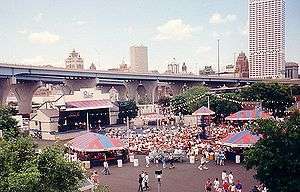 |
1968–present | Milwaukee, Wisconsin | Billed as "The World's Largest Music Festival" by the Guinness World Records since 1999,[36][37] this 11-day event is held between late June and early July, encompassing all genres of musical styles. | |
| Newport Pop Festival | 1968–1969 | Costa Mesa, California | August 3–4, 1968. The first music concert ever to have more than 100,000 paid attendees. Also held the following year. | |
| Isle of Wight Festival |
|
Isle of Wight, England | 31 August and 1 September 1968. Progressive rock counterculture event. The 1970 event was by far the largest of the early ones, and led, in 1971, to Parliament passing the "Isle of Wight Act" preventing gatherings of more than 5,000 people on the island without a special license. | |
| Sky River Rock Festival | 1968–1970 | near Sultan, Washington | First held Aug 31–Sep 2, 1968 (as well as Aug 30-Sep 1, 1969; Aug 28-Sep...1970), it was the first multi-day outdoor hippie rock festival at an undeveloped site.[38] Included the Lighter Than Air Fair. | |
| Internationale Essener Songtage | 1968 | Essen, Germany | September 1968. Krautrock arose at this first major, weeklong, indoors German rock festival.[39] | |
| Hyde Park Free Concerts | 1968–1976 | Hyde Park, London | UK—single-day events | |
| San Francisco Pop Festival | 1968 | Pleasanton, California | Held Saturday October 26 & Sunday October 27, 1968. The groups playing at the festival included The Animals, Creedence Clearwater Revival, etc. | |
| Los Angeles Pop Festival | 1968 | Los Angeles, California | The dates were December 22 and 23, 1968, with groups such as Blue Cheer, The Box Tops, Canned Heat, etc. | |
| Miami Pop Festival | 1968 | Hallandale, Florida | December 28–30, 1968. This event drew an estimated 100,000 people, was the first major rock festival on America's east coast, and was produced by Tom Rounds, who had previously produced the seminal Fantasy Fair and Magic Mountain Music Festival. Performers included Chuck Berry, Joe Tex, Marvin Gaye, Flatt and Scruggs, The Turtles, Procol Harum, The Amboy Dukes, Steppenwolf, and the Paul Butterfield Blues Band. | |
| Palm Springs Pop Festival | 1969 | Palm Springs, California | Held April 1–2, 1969,[40] it was actually two separate one day events. The first was at the Sunair Drive-in in Cathedral City and was called the Palm Springs Pop Festival. Lee Michaels, Procol Harum and John Mayall were the closing acts that day. Day 2 was called the San Andreas Boogie held at the LA Angels summer training baseball field. There was a prediction of an earthquake that day (didn't happen). Buddy Miles Band, Savoy Brown and Canned Heat were the closing acts. The situation went sour when policing efforts militarized the event and there were riots,[19] and a young concert-goer was shot and killed by a nearby store clerk. Concert permits were not issued in Palm Springs afterwards for many years.[41] | |
| Big Rock Pow-Wow | 1969 | West Hollywood, Florida | Took place on Friday, Saturday, and Sunday, May 23, 24, and 25, 1969, at the Hollywood Seminole Indian Reservation in West Hollywood, Florida. Artists who performed at the festival included Grateful Dead, Johnny Winter, Rhinoceros, Muddy Waters, the Youngbloods, with Timothy Leary speaking from the stage. | |
| Northern California Folk-Rock Festival II | 1969 | San Jose, California | May 23–25, the festival featured The Jimi Hendrix Experience, Jefferson Airplane, etc. | |
| First Annual Detroit Rock & Roll Revival | 1969 | Detroit, MI | May 30–31, 1969, held at the Michigan State Fairgrounds. Local artists such as Sun Ra played, as well as Chuck Berry, MC5 and The Stooges.[42] | |
| Newport 69 Pop Festival | 1969 | Northridge, Los Angeles | June 20–22, 1969 | |
| Toronto Pop Festival | 1969 | Toronto | June 21–22, 1969 | |
| Bath Festival of Blues | 1969 | Somerset, England | Saturday 28 June 1969. Developed by Freddy Bannister and Wendy Bannister, it had a lineup of British blues bands, including Fleetwood Mac (the headliners), John Mayall's Bluesbreakers, Ten Years After, Led Zeppelin, The Nice, Chicken Shack, Jon Hiseman's Colosseum, Mick Abrahams' Blodwyn Pig amongst others.[43] | |
| Denver Pop Festival |
1969 | Denver, Colorado | Three-day music festival promoted by rock promoter Barry Fey (Feyline) on June 27-June 29, 1969 which was largely overshadowed by Woodstock two months later. With the full support and local resources of Denver, the peak attendance was estimated at 50,000. | |
| Mississippi River Festival | 1969–1980 | Edwardsville, IL | MRF consisted of a variety of popular rock, folk, bluegrass, and classical music performers.[44] The more popular groups, such as The Who, Yes, Chicago, Eagles, and Grateful Dead shows were heavily attended. Some shows attracting crowds in excess of 30,000.[45] In July 1969, Bob Dylan did a short surprise gig, together with The Band. It was his first performance since his notorious motorcycle accident in 1966. | |
| Atlanta International Pop Festival I | 1969 | Hampton | The first Atlanta festival was held July 4–5, 1969, at the Atlanta International Raceway in Hampton, Georgia, twenty miles south of Atlanta, and drew a crowd of around 100,000.[46] Performers included Led Zeppelin, Janis Joplin, Creedence Clearwater Revival, Joe Cocker, Canned Heat, and Chicago Transit Authority. | |
| The Stones in the Park | 1969 | Hyde Park, London | Free outdoor concert by The Rolling Stones held on 5 July 1969, also featuring Third Ear Band, King Crimson, Screw, Alexis Korner's New Church, Family and The Battered Ornaments,[47] in front of a crowd estimated at between 250,000[47] and 500,000 fans.[48][49][50] | |
| Laurel Pop Festival | 1969 | Laurel, MD | A music festival held at the Laurel Race Course in Laurel, MD on July 11–12, 1969. The festival featured Buddy Guy, Al Kooper, Jethro Tull, Johnny Winter, Edwin Hawkins and Led Zeppelin (on July 11); and Jeff Beck, Ten Years After, Sly and the Family Stone, The Mothers of Invention, Savoy Brown and Guess Who (on July 12).[51] | |
| Summer Pop Festival | 1969 | Had Led Zeppelin at the Summer Pop Festival on 12 July,[52] | ||
| Midwest Rock Festival | 1969 | Milwaukee, Wisconsin | A music festival held at the State Fair Park on the July 25–27, 1969. The festival featured Led Zeppelin, Buffy Sainte-Marie, The First Edition, Sweetwater, Pacific Gas & Electric, SRC and Shag (July 25); Blind Faith, etc. | |
| Seattle Pop Festival |
1969 | Woodinville, Washington | Twenty-six musicians and groups performed at the festival, including Chuck Berry, Black Snake, Tim Buckley, The Byrds, Chicago Transit Authority, Bo Diddley, The Doors, etc. July 25–27. | |
| Singer Bowl Music Festival | 1969 | The Singer Bowl Music Festival on 30 August featured Led Zeppelin.[53] | ||
| Atlantic City Pop Festival | 1969 | Atlantic City, New Jersey | took place in 1969 on August 1, 2 and 3rd at the Atlantic City race track, two weeks before Woodstock Festival. Attended by some 100,000+ people, the festival featured the following performers: Creedence Clearwater Revival, Santana, etc. | |
| Woodstock |
1969 | Bethel, New York | This historically and culturally notable festival served as a defining moment for baby boomers. Performers included Joe Cocker, Jimi Hendrix and Santana among many others, with genres such as acoustic music, progressive rock, and psychedelic rock. August 15–18, audience of over 400,000 young people. | |
| Vancouver Pop Festival |
1969 | Squamish, British Columbia | Canadian rock festival held on August 22, 23 and 24, 1969, Paradise Valley Resort, Squamish. It was produced by Candi Promotions. The groups playing at the festival included The Chambers Brothers, Chicago, Alice Cooper, etc. | |
| Texas International Pop Festival | 1969 | Lewisville, Texas | It occurred two weeks after Woodstock. The site for the event was the newly opened Dallas International Motor Speedway. The festival was the brainchild of Angus G. Wynne III, son of Angus G. Wynne, the founder of the Six Flags Over Texas Amusement Park. Artists performing at the festival were: Canned Heat, Chicago, James Cotton, Led Zeppelin, etc. The Merry Pranksters, Ken Kesey's group, was in charge of the free stage and camping area. Attendance at the festival remains unknown, but is estimated between 120,000 and 150,000. | |
| New Orleans Pop Festival | 1969 | Prairieville, Louisiana | On August 30 - September 1 at the Louisiana International Speedway, the festival featured 26 bands, including seven veterans of Woodstock which was held two week prior such as Janis Joplin, the Grateful Dead, and Jefferson Airplane. Peak attendance was estimated at 35,000. | |
| Toronto Rock and Roll Revival | 1969 | Toronto, Ontario | One-day, twelve-hour music festival held on September 13, 1969. With a number of popular rock & roll acts from the 1950s and 1960s, it also featured an appearance by John Lennon and Yoko Ono, and The Doors. | |
| Palm Beach Pop Festival | 1969 | Palm Beach, Florida | November 28–30, 1969, the event featured artists such as Janis Joplin and the Rolling Stones.[54] Held only one year. the event met with a number of logistical difficulties, including rain and lack of supplies. The local police also heavily militarized the event, and the promoters were bankrupted.[55] | |
| Altamont Free Concert | 1969 | Altamont Speedway, California | Genres included Rock and folk, including blues-rock, folk rock, jazz fusion, Latin rock, and psychedelic rock styles. Actually a free Rolling Stones gig, it featured, in order of appearance: Santana, Jefferson Airplane, The Flying Burrito Brothers, etc. December 6, 1969. One audience member was stabbed to death by the Hell's Angels, who were hired as security for the concert. | |
| Miami Rock Festival | 1969 | Pembroke Pines, Florida | December 27–29, 1969, held at the Hollywood Speedway Park near Miami. The lineup included acts such as Motherlode, Sweetwater, and Canned Heat performed. Police searched fans, making 47 arrests, and a young audience member died after falling from a spotlight tower.[56] |
1970s
| Name | Years | Location | Notes | ||
|---|---|---|---|---|---|
Festival of Political Songs |
1970–1990 | East Germany | Generally held in mid to late February, this festival was a major cultural event for the Free German Youth organization, featuring select political music. | ||
| Hollywood Music Festival | 1970 | Staffordshire, England | 23 and 24 May 1970, it was notable for the first performance of the Grateful Dead in the UK. This was the first of the major festivals held in the summer of 1970 and part of the festival was to have been filmed by the BBC.[57][58] | ||
| The Kickapoo Creek Rock Festival | 1970 | Heyworth, Illinois | The Kickapoo Creek Rock Festival was held on Memorial Day Weekend in May 1970 near Heyworth, Illinois. The Grim Reapers provided the festival security. Approximately 60,000 people attended the festival.[18] | ||
| World Popular Song Festival | 1970–1989 | Japan | With a pop music focus, it was also known as Yamaha Music Festival and unofficially as the "Oriental Eurovision", was an international song contest held from 1970 until 1989. | ||
| Atlanta International Pop Festival II | 1970 | Byron, Georgia | The second and last Atlanta Pop Festival was held July 3–5, 1970, slightly east of Byron, Georgia, 100 miles south of Atlanta, and drew a crowd of over two hundred thousand. Jimi Hendrix was the headliner. | ||
| Super Concert '70 | 1970 | Berlin, Germany | A one-day music festival on September 4, 1970. The festival was headlined by Jimi Hendrix, and was his next to last performance. He appeared on stage once more at the Open Air Love & Peace Festival in Fehmarn, Germany, on September 6, 1970. | ||
| Aachen Open Air Pop Festival | 1970 | Germany | The "Soersfestival", as it is most commonly called, was the initiative of three local students. Some 50,000 visitors attended. | ||
| Piedra Roja | 1970 | Chile | between 10 and 12 October 1970 in the eastern area of Santiago. Among others, the following bands performed in the festival: Aguaturbia, Los Blops, Lágrima Seca and Los Jaivas. | ||
Bath Festival of Blues and Progressive Music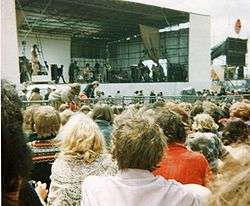 |
1970 | Shepton Mallet, Somerset | The festival featured a line-up of the top American west coast and British bands of the day, including Santana, The Flock, Led Zeppelin (headlining act), Pink Floyd, etc. | ||
| Phun City | 1970 | Worthing, Sussex | Featuring alternative rock and rock, it was organised by the UK Underground anarchist Mick Farren, the festival was notable for having no fences and no admission fees. | ||
| Kralingen Music Festival | 1970 | Rotterdam, the Netherlands | Performing bands included The Byrds, T. Rex, Santana, Jefferson Airplane, and the headlining Pink Floyd. Approximately 150.000 attended. | ||
| Strawberry Fields | 1970 | Bowmanville, Ontario | Although accounts vary, the audience has been estimated at between 75,000 and 100,000 people. Bands such as Jethro Tull and Alice Cooper performed. | ||
| Ruisrock | 1970–present | Turku, Finland | Second oldest rock festival in Europe and the oldest in Finland. The all-time attendance record was set in 1971, when there were about 100,000 visitors, with artists such as Canned Heat playing. | ||
| Pinkpop Festival | 1970–present | Landgraaf, Netherlands | A large, annual pop music festival initially held at Geleen, the Netherlands. Incorporates many genres, and early on was known for focusing on progressive rock. The oldest, still running rockfestival of the world. | ||
Powder Ridge Rock Festival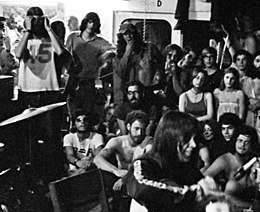 |
1970 | Middlefield, Connecticut | July 31-August 2, 1970, Middlefield, CT, the event was cancelled last minute, though thousands of concert-goers still attended the venue. | ||
| Goose Lake International Music Festival | 1970 | Michigan | August 7–9, 1970,[59] the Goose Lake promoters wanted better planning and facilities than Woodstock.[60] The stage was built on a revolving turntable with two performance spaces. At the end of each performance, the stage would rotate 180 degrees, and the next act would begin performing almost immediately.[61] An estimated 200,000 rock music fans attended the festival. The initial attitude of the "young, hip police force"[60] to fans was to "leave them alone",[62] though there were 160 arrests of those leaving after the event, mostly on drug charges.[63] | ||
| Man-Pop Festival | 1970 | Winnipeg, Manitoba | Held August 29, 1970, Led Zeppelin was the headlining act at the event. Other artists performing at the festival included The Youngbloods, The Ides of March, Iron Butterfly, Chilliwack, plus local bands, including Dianne Heatherington and The Merry Go Round.[64] | ||
| Glastonbury Festival |
|
Pilton, Somerset | In addition to contemporary music, the festival hosts dance, comedy, theatre, circus, cabaret, and other arts. It is organized by Michael Eavis on his own farm land. The first ever opening act was the English progressive rock group Stackridge. | ||
Vortex I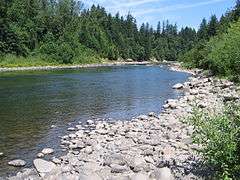 |
1970 | Oregon | A week-long rock festival sponsored by the Portland counterculture community with help from the U.S. state of Oregon. The music at the festival was primarily performed by local acts. It is the only state-sponsored rock festival in United States history. | ||
| White Concert | 1971 | Monterrey, Mexico | in February 1971 in Monterrey, a collective band called Sierra Madre and a state-of-the-art lights spectacle named "Music and light show" faced repression after a failed attempt to hold a three-day concert, called Concierto Blanco (white concert) inside the State government palace in Monterrey's main square. The violent incidents after the White concert, which were extensively covered by the media, seriously damaged then Nuevo Leon governor Eduardo Elizondo's political career.[65] | ||
| Festival Buenos Aires Rock | 1971 | Argentina | Major hippie festival held in Argentina.[66] | ||
| Festival de Ancon | 1971 | Colombia | Major pop festival held in Colombia, held 18 to the 20th of June | ||
| Roskilde Festival | 1971–present | Roskilde, Denmark | Denmark's first real music-oriented festival, originally towards counter-culture music such as psychedelic rock. 2013 had more than 180 bands and around 130,000 festival goers. | ||
| Myponga Pop Festival | 1971 | Myponga, South Australia | Over three days in the summer of 1971. The festival was headlined by heavy metal pioneers Black Sabbath. Other performers included Australian acts Daddy Cool, Spectrum, Fraternity, Billy Thorpe and the Aztecs and Chain.[67] | ||
| Celebration Of Life | McCrea, Louisiana | An 8-day festival without proper facilities for the 60,000+ attendees. This debacle is the subject of a documentary, McCrea 1971, which can be seen at http://www.mccrea1971.com | |||
Bumbershoot |
1971–present | Seattle, Washington | One of North America's largest annual international music and arts festivals, held in Seattle, Washington every Labor Day weekend. It features a large amount of rock and experimental artists and genres, which in 1990s included the local grunge genre, and recently has included indie rock. | ||
| Ilosaarirock | 1971–present | Joensuu, Finland | The second oldest rock festival in Finland still active, and one of the oldest in Europe. Progressive rock bands featuring electronic features frequently perform. | ||
| Weeley Festival | 1971 | PLACE | August 27–29, 1971, Weeley, UK | ||
| Festival Rock y Ruedas de Avándaro | 1971 | Valle de Bravo, Mexico | September 11–12, 1971, Valle de Bravo, Mexico | ||
| Sunbury Pop Festival | 1972–1975 | Australia | 26 January, held at Diggers Rest, Victoria. | ||
| Erie Canal Soda Pop Festival | 1972 | Bull Island, Griffin, Indiana | A crowd estimated at 200,000 to 300,000 attended the concert, four times what the promoters estimated. Food and water were in short supply, and the gathering descended into relative anarchy. After the show was finished, remnants of the crowd burned the main stage.[68] | ||
| Bickershaw Festival | 1972 | Bickershaw, England | Held in Bickershaw (Wigan, Lancashire), England, between 5 and 7 May 1972.[69] Except for the 1976–79 Deeply Vale Festivals, Bickershaw was the only major north-west multi-day festival with camping. | ||
| Concert 10/Mt. Pocono Rock Festival | 1972 | Long Pond, Pennsylvania | July 8 and 9 of 1972. The event attracted an estimated 200,000 people who were met with cold inclement weather, replete with rain and mud. | ||
Mar Y Sol Pop Festival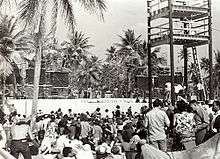 |
1972 | Manatí, Puerto Rico | An estimated 30–35,000 people attended the festival. An arrest warrant was issued for promoter Alex Cooley, who avoided arrest by leaving the island before the festival was over. Performers included the Mahavishnu Orchestra, The Faces, Alice Cooper, The Allman Brothers Band, Billy Joel, Cactus, Osibisa, B. B. King, and others. | ||
| Windsor Free Festival | 1972–1974 | Windsor Great Park, England | A British Free Festival organised by some London commune dwellers, notably Ubi Dwyer and Sid Rawle. The event was brutally suppressed by the police, which led to a public outcry about the tactics involved. In 1975 both Ubi Dwyer and Sid Rawle were imprisoned, for attempting to promote a 1975 Windsor Festival.[11] | ||
| BOOM Festival | 1972–1978 | Yugoslavia | A rock music festival, held in several cities of Yugoslavia: three editions of the festival were held in Ljubljana, one in Zagreb, one in Belgrade and two in Novi Sad. The festival featured numerous prominent acts of the former Yugoslav rock scene, and five various artists live albums were recorded on various editions of the festival.[26] | ||
| The Great Ngaruawahia Music Festival | 1973 | New Zealand | the first large outdoor music festival in New Zealand. It was held on a farm at Ngāruawāhia on the Waikato River for three days from 6 to 8 January 1973.[70] | ||
| Aquarius Festival | 1973 | Australia | A counter-cultural arts and music festival organised by the Australian Union of Students. The first NUAUS festival was held in Sydney ca 1966,[71] while the second, Melbourne, third in Canberra and last (Aquarius) was held in Nimbin, New South Wales in 1973.[72] Estimated turn-up at Nimbin was from 5,000 to 10,000 people. It is often described as Australia's equivalent to the Woodstock Festival and the birthplace for Australia's hippie movement.[73] | ||
| Day on the Green | 1973–1991 | Oakland, California | First held August 5, 1973, it was a recurring concert in Oakland, California presented by promoter Bill Graham and his company Bill Graham Presents. Held at the Oakland Coliseum, these events began in 1973 and continued into the early 1990s. The last Day on the Green overseen by Graham took place the same month as his death in a helicopter crash in 1991. Headliners the first year included bands such as Elvin Bishop, Merry Clayton, while the Grateful Dead appeared the second. | ||
| Summer Jam at Watkins Glen | 1973 | Watkins Glen, New York | Once received the Guinness Book of World Records entry for "Largest audience at a pop festival." An estimated 600,000 rock fans came to the Watkins Glen Grand Prix Raceway outside of Watkins Glen, New York on July 28, 1973, to see the Allman Brothers Band, Grateful Dead and The Band perform. | ||
| Hurricane Festival | 1973–present | Scheeßel, Germany | In June 1973, the first festival was held in Scheeßel, the place where today's Hurricane takes place. It was called "Es rockt in der Heide" at that time (literally translated: It's rocking in the heath) and was attended by 52,000 people. | ||
Stonehenge Free Festival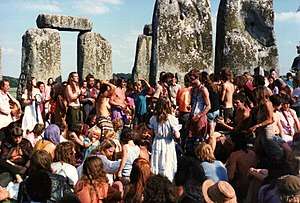 |
1974–1984 | Stonehenge, England | Important free festival that happened during the month of June, and culminating on the summer solstice on June 21. A celebration of countercultures, with New Age Travellers and the Wallys attending. Hosted bands including Hawkwind, Gong, Doctor and the Medics, Flux of Pink Indians, Thompson Twins, etc. | ||
| Ashton Court Festival | 1974–2007 | Bristol, England | Held annually in mid-July, starting as a small one-day festival in 1974, the festival grew during succeeding years and was said to be Britain's largest free festival until changes brought on by government legislation resulted in compulsory fees and security fencing being introduced. | ||
| Knebworth Festival | 1974 | England | |||
| Village Fair | 1974–present | Bathurst, Australia | Annual community festival that began in 1974 with increasingly expanded performances such as local indie music acts and Australian headliners. New venue in 2007, and a music festival almost double in size of any previous years. | ||
| Zaire 74 | 1974 | Kinshasa, Zaire | A three-day live music festival that took place on September 22 to 24, 1974 at the 20th of May Stadium in Kinshasa, Zaire (now Democratic Republic of the Congo). The concert, conceived by South African trumpeter Hugh Masekela and record producer Stewart Levine, the Zaire 74 event was intended to present and promote racial and cultural solidarity between African American and African people, with performers such as B.B. King. 80,000 people attended. | ||
Ozark Music Festival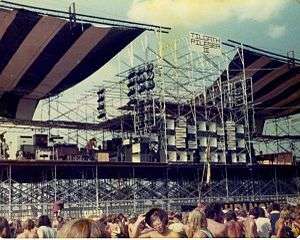 |
1974 | Sedalia, Missouri | Held July 19–21, 1974 on the Missouri State Fairgrounds, some estimates have put the crowd count at 350,000 people. | ||
| Rock Werchter | 1974–present | Werchter, Belgium | Can host 88,000 guests daily | ||
| California Jam | 1974 | Ontario, California | Co-headlined by Deep Purple and Emerson, Lake & Palmer, held at the Ontario Motor Speedway on April 6, 1974.[74] It attracted 250,000[75] paying fans. The festival set what were then records for the loudest amplification system ever installed, the highest paid attendance, and highest gross in history. | ||
| Watchfield Free Festival | 1975 | Watchfield, England | On 23–31 August 1975, a former military site at Watchfield became the location of the People's Free Festival which had been held during the previous three years, despite opposition, in Windsor Great Park. The Windsor Free Festivals had been violently terminated by the police in 1974. This new site was offered as an alternative venue due to government embarrassment at previous police actions and was attended by several thousand people. Musicians who performed there included Hawkwind and Vivian Stanshall. Watchfield Free Festival was the only Free festival to be government sponsored (with assistance by then-Home Secretary Roy Jenkins), or be given official recognition. | ||
| Michigan Womyn's Music Festival | 1976–2015 | Michigan | Called "the Original Womyn's Woodstock"[76] and often referred to as MWMF or Michfest, is an international feminist music festival held every August in a small wooded area known as "The Land." The event is completely built, staffed, run and attended by women.[77] | ||
| European Punk Rock Festival | 1976 | Mont de Marsan, France | In August 1976, the self-described "First European Punk Rock Festival". Eddie and the Hot Rods, a London pub rock group, headlined. The Sex Pistols, originally scheduled to play, were dropped by the organizers who said the band had gone "too far" in demanding top billing and certain amenities; The Clash backed out in solidarity.[78] Organised by Zermati, took place at Mont-de-Marsan on 21 August 1976, and featured French bands Bijou, Il Biaritz and Shakin’ Street, as well as The Damned.[79] | ||
| Midtfyns Festival | 1976–2003 | Ringe, Denmark | In the festival's heyday it was competing with Roskilde Festival to be the biggest music event in Northern Europe, mostly due to Phish's appearance at the festival in 1998. | ||
| Cropredy Convention | 1976–present | Cropredy, England | Annual festival of folk and rock music held second week of August. Attracts up to 20,000 people each year, with ancillary events, such as morris dancing in the streets and live music at the village's two pubs. | ||
| 100 Club Punk Festival | 1976 | Oxford Street, London | A two-day event held at the 100 Club, a typically jazz-oriented venue in Oxford Street, London, England, on 20 and 21 September 1976.[80] The gig showcased eight punk rock bands, most of which were unsigned. The bands in attendance were each associated with the evolving punk rock music scene and movement of the United Kingdom. The concert marked a watershed for the movement, as punk began to move from the underground and emerge into the mainstream music scene. | ||
| Paléo Festival | 1976–present | Nyon, Switzerland | 2005 had 3.5 million spectators | ||
| Deeply Vale Festivals | 1976–1979 | England | The Deeply Vale Festivals were unique free festivals held near Bury in northwest England in 1976 through 1979. They are regarded as significant events that united punk music into the festival scene. | ||
Nambassa |
1976–1981 | New Zealand | A series of hippie-conceived festivals held between 1976 and 1981 on large farms around Waihi and Waikino in New Zealand. They were music, arts and alternatives festivals that focused on peace, love, and an environmentally friendly lifestyle. The January 1979 three-day event attracted over 75,000 patrons making it the largest arts, multiple cultural and popular music event of its type in the world.[81] | ||
| Waikino Music Festival | 1977 | New Zealand | |||
| California Jam II | 1978 | Ontario, California | March 18, 1978 and produced by Leonard Stogel, Sandy Feldman, and Don Branker.[82][83] More than 350,000 people attended. The event was promoted by Wolf and Rissmiller Concerts. | ||
| Texxas Jam | 1978–1988 | Dallas, Texas Houston, Texas | Annual summer arena rock concert called the Texxas World Music Festival (1978–1988). It was held in Dallas at the Cotton Bowl, and in Houston, at either the Astrodome or the Rice Stadium on the campus of Rice University. Inspired by California Jam II, Texxas Jam was created by Louis Messina and David Krebs. Over 100,000 attended the first Texxas Jam on July 1, 1978, the hottest day of the decade (the temperature reached 104 degrees). It was the first southern stadium rock show since ZZ Top played to 80,000 people at UT Austin on September 1, 1974 and tore up the field. | ||
| Canada Jam | 1978 | Canada | Held on August 26, 1978. The festival was produced by Sandy Feldman and Leonard Stogel, who produced California Jam and California Jam II, and was sponsored by Carling O'Keefe. It attracted over 110,000 fans, making it the largest paying rock event in Canadian history at that time.[84] |
1980s–2020s
| Festival name | Location | Years | Details | |
|---|---|---|---|---|
| Heatwave | Canada | 1980 | Important event for new wave and punk | |
| Spring Rhythms. Tbilisi-80 | Soviet Union | 1980 | First official rock festival in the Soviet Union | |
| Elephant Fayre | England | 1980-'86 | Lineup blended reggae/rock with major punk acts | |
| US Festival | California | 1982-'83 | Meant to fuse rock and technology | |
| Super Rock '84 in Japan | Japan | 1984 | The lineup included Bon Jovi, Whitesnake, Scorpions, Michael Schenker Group and Anvil | |
| Live Aid | London/Philadelphia | 1985 | 13 July 1985, held in two countries | |
| Battle of the Beanfield | England | 1985 | Police action against free festival | |
| Rock in Rio | Brazil | 1985–present | 1.5 million people attended the first event | |
| Super Rock '85 in Japan | Japan | 1985 | The lineup included Dio, Foreigner, Sting, Mama's Boys and Rough Cutt | |
| Street Scene | California | 1986-'09 | One of the largest annual US music festivals | |
| Rendez-vous Houston | Texas | 1986 | Largest ticketed event in North America, 1 to 1.5 mill. attendees | |
| Moscow Music Peace Festival | Soviet Union | 1989 | Important event for glam metal | |
| Livid | Australia | 1989–2003 | Alternative rock festival for international and local bands | |
| Wacken Open Air | Germany | 1990–present | Large metal showcase | |
| International Pop Underground Convention | Washington | 1991 | Punk and indie rock festival | |
| Lollapalooza | Chicago | 1991–present | Focus on alternative rock/hip hop | |
| Big Day Out | Australia | 1992–2014 | Multiple stages and genres | |
| Sziget | Hungary | 1993–present | Large Woodstock style event | |
| Woodstock '94 | United States | Aug 12–14, 1994 | First real Woodstock Festival since the 1969 Festival. 350,000+ in attendance,
much like the original Woodstock as it rained that weekend and there was mud and fun. Several of the original artists from the 1969 Festival performed. Peaceful crowd and no problems. Widely known as Generation X's Woodstock. | |
| Whitby Goth Weekend | England | 1994–present | Large goth/industrial festival | |
| Przystanek Woodstock | Poland | 1995–present | Ticket-free festival with crowds up to 625,000 | |
| Vans Warped Tour | United States | 1995–2018 | Punk rock showcase | |
| V Festival | England | 1996–present | Two concurrent stages | |
| Fuji Rock Festival | Japan | 1997–present | In 2005, more than 100,000 people attended | |
| Nashestvie | Russia | 1999- | One of largest Russian rock open-air festivals | |
| Coachella Valley Music and Arts Festival | California | 1999–present | In 2014 had 579,000 attendees over six days | |
| Woodstock 1999 | Rome, New York | 1999 | Known as a commercial and crowd control disaster | |
| Summer Sonic Festival | Japan | 2000–present | Major commercial festival | |
| Exit Festival | Serbia | 2000–present | Exit 2008 had 25 stages | |
| Rock in Roma | Italy | 2002–present | Several groups perform over a month | |
| Bonnaroo Music And Arts Festival | Tennessee | 2002–present | Initial jam band focus, now multi-genre | |
| Download Festival | England | 2003–present | Heavy metal and alt rock focus | |
| Molson Canadian Rocks for Toronto | Canada | 2003 | Largest outdoor ticketed event in Canada (~half a mill.) | |
| Soundwave | Australia | 2004–2015 | Alt rock and metal/punk focus | |
| Oxegen | Ireland | 2004-'13 | One of largest rock/pop festivals in Ireland | |
| Live 8 | - | Many | 2005 | Ten simultaneous benefit concerts in 8 countries |
| WaveAid | Australia | 2005 | Benefit Concert in Sydney for 2004 Indian Ocean earthquake | |
| Live Earth | - | Worldwide | 2007 | Widely broadcast worldwide |
| Sound Relief | Australia | 2009 | Benefit Concert in Sydney and Melbourne | |
| El Abrazo 2010 | Santiago, Chile | 2010 | Festival that brought together rock musicians from Chile and Peru to celebrate the bicentennial of both countries. | |
| Fire Fight Australia | Australia | 2020 | Benefit Concert in Sydney for 2019–20 Australian bushfire season |
Traveling festivals
A recent innovation is the traveling rock festival where many musical acts perform at multiple locations during a tour. Successful festivals are often held in subsequent years. The following is an incomplete list.
- Anger Management Tour
- Area Festival
- Australian Made
- Big Day Out
- Crüe Fest
- Curiosa
- Deconstruction Tour
- Family Values Tour
- Festival Express
- G3
- Gigantour
- Rock Boat
- Hard Electric Tour
- Lilith Fair
- Lollapalooza
- Knotfest
- Mayhem Festival
- Magic Circle Festival
- Monsters of Rock
- Nintendo Fusion Tour
- Ozzfest
- Projekt Revolution
- Persistence Tour
- Rock Never Stops Tour
- Sad Summer Festival[85]
- Sonisphere Festival
- Sounds Of The Underground
- Soundwave
- Summer Sanitarium
- Taste of Chaos
- The Unholy Alliance Tour
- Uproar Festival
- Warped Tour
List of rock festivals
The following is a list of some notable rock festivals that take place on a regular basis. Most are held at the same location on an annual basis. Some, like Farm Aid are held at different venues with each incarnation. For a full list of festivals, see the external links at the bottom of the page.
No fixed location
- Terrastock (historically North America or Britain)
North America
.svg.png)
- Amnesia Rockfest (Montebello, Québec)
- Edgefest (Toronto, Ontario)
- Heavy Montreal (Montreal)
- Osheaga (Montreal)
- Pemberton Music Festival (Pemberton, BC)
- Rockin' the Fields of Minnedosa (Manitoba)
- Rock the River (Saskatoon, Saskatchewan)
- Rogers Picnic (Toronto, Ontario)
- V Festival (Canada, United States)
- Woodstock en Beauce

- Festival Presidente de la Musica Latina (Distrito Nacional)

- Aftershock Festival (Sacramento, California)[86]
- Austin City Limits (Austin, Texas)
- Big Ass Show (Salt Lake City, Utah)
- Bonnaroo Music Festival (Manchester, Tennessee)
- BottleRock Napa Valley (Napa, California)
- Bumbershoot (Seattle, Washington)
- Chris Jericho's Rock 'N' Wrestling Rager at Sea (Miami, Florida)
- Coachella Valley Music and Arts Festival (Indio, California)
- DC101 Chili Cookoff (Washington D.C.)
- Dog Jam (Beaumont, Texas)
- Earthday Birthday (Orlando, Florida)
- Epicenter (Concord, North Carolina)
- Farm Aid (United States)
- The Fest (Gainesville, Florida)
- Firefly Music Festival (Dover, Delaware)
- Governors Ball Music Festival (New York, New York)
- KaaBoo, September/Annual (Del Mar, California)
- Kerrville Folk Festival, annually since 1972, (Kerrville, Texas)
- Lollapalooza (Chicago, Illinois)
- Loud-N-Lima, July 2017, (Lima, Ohio)
- Louder Than Life (Louisville, Kentucky)[87]
- Moondance Jam (Walker, Minnesota)
- Mountain Jam (Hunter, New York)
- Okeechobee Music & Arts Festival (Okeechobee, Florida)
- Outside Lands Music & Arts Festival (San Francisco, California)
- Pointfest (St. Louis, Missouri)
- Rebel Rock (Orlando, Florida)[88]
- Rock Fest (Cadott, Wisconsin)
- Rock N Resort Music Festival (North Lawrence, Ohio)
- Rock USA (Oshkosh, Wisconsin)
- Rocklahoma (Pryor, Oklahoma)
- ShipRocked (Miami, Florida)
- Sonic Temple Art & Music Festival (Columbus, Ohio)
- South by Southwest (Austin, Texas)
- Summerfest (Milwaukee, Wisconsin)
- Treefort Music Fest (Boise, Idaho)
- Volunteer Jam (Nashville, Tennessee)
- Voodoo Music Experience (New Orleans, Louisiana)
- Welcome to Rockville (Jacksonville, Florida)
- 98RockFest (Tampa, Florida)
South America
Argentina
- Cosquin Rock (Córdoba)
- Lollapalooza Argentina (San Isidro, Buenos Aires)
- Moonpark (Buenos Aires)
- Nokia Trends (Mar del Plata)
- Pepsi music festival (Buenos Aires)
- Personal fest (Buenos Aires)
- Quilmes Rock (Buenos Aires)
Brazil
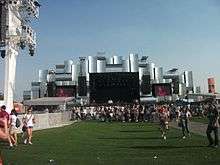
Chile
- Chiloe Metal Fest (Castro, Chiloé Island)
- La Cumbre, previously called La Cumbre del Rock Chileno (Santiago, Chile)
- Lollapalooza Chile (Santiago, Chile)
- Maquinaria Festival (Santiago, Chile)
- Primavera Fauna (Santiago, Chile)
- Rock en Conce, a.k.a. REC (Concepción, Chile)
- Viña del Mar International Song Festival (Viña del Mar)
Colombia
Paraguay
- Asunciónico (Asunción)
- Pilsen Rock (Asunción)
- Reciclarte (San Bernardino)
Peru
- Vivo por el Rock (Lima)
- Rock in Concert (San Isidro District, Lima)
- Viva Peru (All over the country)
Uruguay
- antelfest (Piriápolis, Maldonado)
- Pilsen Rock (Durazno)
- Montevideo Rock (Montevideo)
- Punta Rock (Punta del Este, Maldonado)
Europe
Belgium
- Graspop Metal Meeting (Dessel)
- Groezrock (Gestel)
Denmark
Finland
- Ankkarock (Vantaa)
- Down By The Laituri (Turku)
- Finnish Metal Expo (Helsinki)
- Funky Elephant (Helsinki)
- Ilosaarirock (Joensuu)
- Jalometalli Metal Music Festival, (Oulu)
- Lumous Gothic Festival (Pyhäjärvi)
- Miljoona Rock (Töysä)
- Pori Jazz (Pori)
- Provinssirock (Seinäjoki)
- Qstock (Oulu)
- Ruisrock (Turku)
- Sauna Open Air (Tampere)
- Tammerfest (Tampere)
- Tuska Open Air (Helsinki)
- Puntala-rock (Lempäälä)
France
- Eurockéennes (Belfort)
- Hellfest (Clisson)
- Soy Festival (Nantes)
- Les Déferlantes (Argelès-sur-Mer)
- Transmusicales (Rennes)
- Vieilles Charrues Festival (Carhaix)
- Rock en Seine (Saint-Cloud)
- Main Square Festival (Arras)
Germany
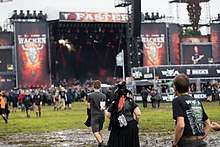
- Bang Your Head!!! (Balingen)
- Hurricane Festival (Scheeßel)
- M'era Luna Festival (Hildesheim)
- Rock am Ring (Nürburgring)
- Southside (Neuhausen)
- Summer Breeze Open Air (Dinkelsbühl)
- Wacken Open Air (Wacken)
- Rhön Rock Open Air (Hünfeld-Oberfeld)
The Netherlands
- Arrow Rock Festival (Biddinghuizen)
- Black Cross festival (Lichtenvoorde)
- Dynamo Open Air (Eindhoven)
- Lowlands (Biddinghuizen)
- Parkpop (The Hague)
- Pinkpop Festival (Landgraaf)
Norway
- Bukta Tromsø Open Air Festival (Tromsø)
- Hove Festival (Tromøya)
- Norway Rock Festival (Kvinesdal)
- Øyafestivalen (Oslo)
- Bergenfest (Bergen)
- Periferifestivalen (Bergen/Sotra)
Portugal
- MEO Marés Vivas (Vila Nova de Gaia)
- MEO Sudoeste Festival (Zambujeira do Mar)
- NOS Alive (Algés)
- NOS Primavera Sound (Porto)
- Rock in Rio (Lisbon)
- Super Bock Super Rock (Meco)
- Vilar de Mouros Festival (Vilar de Mouros)
- VodafoneParedes de Coura Festival (Paredes de Coura)
Romania
- Artmania Festival (Sibiu)
- Gărâna Jazz Festival (Gărâna/Wolfsberg)
- Peninsula / Félsziget Festival (Tîrgu Mureș)
- Rock the city (Bucharest)
- Bucovina Rock Castle (Suceava)
- Festivalul Celtic Transilvania (Beclean)
Russia
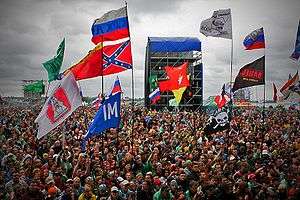
- Nashestvie (Tver Oblast) - the main festival of Russian rock, held annually since 1999.
- Afisha Picnic (Moscow), a multi-genre festival
- Dobrofest (Yaroslavl Oblast)
- InProg (Moscow), a progressive rock festival.
- Kubana Festival (Krasnodar Krai, Russia/Riga, Latvia)
- Krylya Festival (Moscow)
- Maxidrom (Moscow), features both Russian and foreign artists.
- Park Live Festival (Moscow)
- Rock nad Volgoy (Samara)
- VladiROCKstok (Vladivostok)
Sweden
- Hultsfred Festival (Hultsfred)
- Metaltown (Gothenburg)
- Peace & Love (Borlänge)
- Storsjöyran (Östersund)
- Sweden Rock Festival (Sölvesborg)
- Way Out West Festival (Gothenburg)
United Kingdom
- All Tomorrow's Parties (Camber Sands, East Sussex, England)
- Download Festival (Donington Park, Castle Donington, England)
- Fairport's Cropredy Convention (Cropredy, Oxfordshire, England)
- Glastonbury Festival (Pilton, Somerset, England)
- Greenbelt Festival (England)
- Hevy Music Festival (Folkestone, England)
- High Voltage Festival (London, England)
- Isle of Wight Festival (Isle of Wight, England)
- Concerts at Knebworth House (Knebworth, England—single day events)
- Offset festival
- Radio 1's Big Weekend
- Reading and Leeds Festivals (Reading, Berkshire and Leeds, Yorkshire, England)
- Rebellion Festival (Blackpool England)
- Sonisphere Festival (Knebworth Park, Hertfordshire, England)
- T in the Park (Kinross Scotland)
- V Festival (Chelmsford and Staffordshire, England)
- Y Not Festival
Rest of Europe
- Baltijos Garsas (Kernavė, Lithuania)
- Donauinselfest (Vienna, Austria)
- Electric Picnic (County Laois, Ireland)
- Exit (Novi Sad, Serbia)
- Festivali i Këngës (Tirana, Albania)
- FM4 Frequency Festival (Salzburg, Austria)
- Gitarijada (Zaječar, Serbia)
- Hard Rock Laager (Vana-Vigala, Estonia)
- Iceland Airwaves (Reykjavík), Iceland
- Independent Days Festival (Bologna, Italy)
- Kavarna Rock Fest (Bulgaria)
- Masters of Rock (Vizovice, Czech Republic)
- Metaldays (Tolmin, Slovenia)
- Montreux Jazz Festival (Montreux, Switzerland)
- Nova Rock (Nickelsdorf, Austria)
- Open'er festival (Gdynia, Poland)
- Oxegen (Punchestown, Ireland)
- Paléo Festival (Nyon, Switzerland)
- Pohoda (Trenčín, Slovakia)
- PositivusAB (Salacgrīva, Latvia)
- Przystanek Woodstock (Kostrzyn), (Poland)
- Rabarock (Järvakandi, Estonia)
- Rock for People (Hradec Králové, Czech Republic)
- Rock in Roma (Rome, Italy)[89]
- Rock'n Coke (Istanbul, Turkey)
- RockIstanbul (Istanbul, Turkey)
- Rockwave Festival (Athens, Greece)
- Resurrection Festival (Viveiro, Spain)
- Slane Concert (Slane, Ireland)
- Spirit of Burgas (Burgas, Bulgaria)
- Trutnov Open Air Music Festival (Trutnov, Czech Republic)
Oceania
- Big Day Out (Australia and New Zealand)
Australia
- Byron Bay Bluesfest (Byron Bay)
- Download Festival (Melbourne, Sydney)
- Falls Festival (Lorne, Byron Bay, Marion Bay)
- Golden Plains Festival (Meredith, Victoria)
- Good Things Festival (Melbourne, Sydney, Brisbane)
- Good Vibrations Festival (Melbourne, Sydney, Gold Coast, Perth)
- Homebake (Sydney)
- Meredith Music Festival (Meredith, Victoria)
- Pyramid Rock Festival (Phillip Island)
- Splendour In The Grass (Byron Bay)
- Stereosonic (Brisbane, Adelaide, Perth, Sydney, Melbourne)
- Unify Gathering (South Gippsland, Victoria)
- Woodford Folk Festival, Queensland, Australia.
New Zealand
Asia
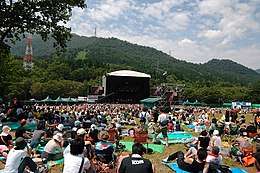
China
- Beijing Pop Festival (Beijing)
- Midi Modern Music Festival (Beijing)
- Modern Sky Festival (Beijing)
Hong Kong
India
- Hard Electric Tour (India)
- Rock In India (Bangalore)
- Rock Ethos (Bangalore)
Indonesia
- Bandung Berisik (Bandung)
- Hammersonic Festival (Jakarta)
- Hellprint (Bandung)
- Java Rockin'land (Jakarta)
- Rock In Borneo (Kutai Kartanegara, East Kalimantan)
- Rock In Celebes (Makassar)
- Rock In Solo (Surakarta, Central Java)
Japan
- Fuji Rock Festival (Naeba)
- Rising Sun Rock Festival (Ishikari)
- Rock In Japan (Hitachinaka)
- Summer Sonic Festival (Chiba and Osaka)
Philippines
South Korea
- ETPFEST (Seoul)
- Jisan Valley Rock Festival (Icheon)
- Pentaport Rock Festival (Incheon)
Taiwan
Middle East and Africa
- Dubai Desert Rock Festival (Dubai, United Arab Emirates)
- Oppikoppi (Northam, South Africa)
Notes
- Retrieved July 10, 2020.
- UKRockFestivals.com Retrieved January 14, 2014.
- Jazz Bilzen history Retrieved January 14, 2014.
- Santelli, Robert. ‘’Aquarius Rising – The Rock Festival Years’’. Pg. 16.
- Browne, David. (2014-06-05). "The Birth of the Rock Fest". Rolling Stone.
- Kubernik, Harvey and Kubernik, Kenneth. A Perfect Haze: The Illustrated History of the Monterey International Pop Festival. 2011. Santa Monica Press LLC. Pg. 54.
- Mankin, Bill. We Can All Join In: How Rock Festivals Helped Change America. Like the Dew. 2012.
- Santelli, Robert. Aquarius Rising - The Rock Festival Years. 1980. Dell Publishing Co., Inc. Pg. 259.
- dannywimmerpresents.com Retrieved December 14, 2019.
- Kane, John (Jan 27, 2020). The Last Seat in the House: The Story of Hanley Sound. Birmingham, AL: Univ. Press of Mississippi. p. 413. ISBN 978-1-4968-2680-0. Retrieved 2020-07-13.
- Hudson, Mark (28 June 2004). "The forgotten festival - I was there". The Daily Telegraph. London. Retrieved 29 August 2014.
- "International Times Vol 3 Issue 1". International Times. June 1975. Archived from the original on 22 July 2011. Retrieved 3 September 2010.
- "International Times Vol 3 Issue 2". International Times. July 1975. Archived from the original on 22 July 2011. Retrieved 3 September 2010.
- "Pop festival 'organiser' sent to jail". ukrockfestivals.com. Retrieved 2 September 2010.
- West, Richard, ed. (June 1976). "Rock Economics". Texas Monthly. Austin: Mediatex Communications Corp. 4 (6): 17–18. ISSN 0148-7736. Retrieved 2010-10-04.
- West, Richard, ed. (November 1976). "Rock on the Rocks". Texas Monthly. Austin: Mediatex Communications Corp. 4 (11): 86, 88. ISSN 0148-7736. Retrieved 2010-10-04.
- Gravy, W. The Hog Farm and Friends, Links Press 1992 pp. 72-74
- Luciano: A Woodstock or laughingstock? - News - Journal Star - Peoria, IL
- Hopkins, Jerry (May 3, 1969). "Vacationing in Palm Springs: A Real Lark". Rolling Stone. Retrieved 2015-05-20.
- "Swamp Pop History". Swamppopmusicfest.com. Retrieved 2010-03-28.
- See George McKay (2002) 'Trad jazz in the 1950s', interviews with Montagu, George Melly, other musicians and fans attending Beaulieu.
- "In praise of ... the Reading festival". The Guardian. London. 25 August 2006. Retrieved 30 June 2014.
- "Reading Rock Festival.Reading 1978".
- Janjatović, Petar (2007). EX YU ROCK enciklopedija 1960-2006. Belgrade: self-released. p. 302.
- Fajfrić, Željko; Nenad, Milan (2009). Istorija YU rock muzike od početaka do 1970. Sremska Mitrovica: Tabernakl. p. 69.
- Janjatović, Petar (2007). EX YU ROCK enciklopedija 1960-2006. Belgrade: self-released. p. 301.
- Fajfrić, Željko; Nenad, Milan (2009). Istorija YU rock muzike od početaka do 1970. Sremska Mitrovica: Tabernakl. p. 72.
- Чикарић, С. "Право грађанства за рокенрол".
- "Koreni jugoslovenskog rocka (4) - Prateće manifestacije".
- Fajfrić, Željko; Nenad, Milan (2009). Istorija YU rock muzike od početaka do 1970. Sremska Mitrovica: Tabernakl. p. 85.
- "Gitarijada - Najstarija rock manifestacija u Evropi".
- Postertrip.com. "The Acid Test Chronicles - Page 17 - Trips Festival 3-Day Acid Test - (7th Test)Longshoremans Hall - Jan 21, 22, 23 1966".
- Tamony, Peter. (Summer, 1981). Tripping out from San Francisco. American Speech. Vol. 56, No. 2. pp. 98–103. Tamony, 1981, p.98
- "pranksterweb.org".
- "Led Zeppelin official website: concert summary". Ledzeppelin.com. 21 July 1969. Retrieved 31 December 2011.
- "OnMilwaukee.com :".
- ""My Midwest" Magazine - Fun in the Sun by Jeanette Hurt; May 1st, 2007". Archived from the original on 2007-06-29. Retrieved 2015-05-27.
- "1968's Sky River Rock Festival revisited Friday". 12 August 2011.
- P. Buckley, The Rough Guide to Rock, (Rough Guides, 1999), ISBN 1858284570, p.26
- "1969: PH at Palm Springs".
- "Explore Palm Springs: 1969 Pop Festival". 16 April 2014.
- McGonigal, Mike. "Detroit needs Sun Ra more than ever, for his poetic afro-futurism, and that joyous noise".
- Bath Festival, June 1969 & June 1970; Mike Watt; in, Classic rock; Issue 109; August 2007; Future Publications; pp.46–47.
- The Mississippi River Festival. Amanda Bahr-Evola and Stephen Kerber. Arcadia Publishing, Copyright 2006. ISBN 978-0-7385-4132-7
- The Mississippi River Festival. Amanda Bahr-Evola and Stephen Kerber. Arcadia Publishing, Copyright 2006. ISBN 978-0-7385-4132-7
- Roberts, Scott. (July 2011). "42 Years Ago This Month: The First Atlanta International Pop Festival" Archived 2013-09-03 at the Wayback Machine. Atlanta Magazine.
- Hjort, Christopher (2007). Strange Brew: Eric Clapton and the British Blues Boom, 1965-1970. London: Jawbone Press. p. 249. ISBN 978-1-906002-00-8.
- "Requiem For A Stone". London: The Observer. 6 July 1969. Retrieved 16 July 2012.
- Richards, Keith; Fox, James. Life. Weidenfeld & Nicolson. p. 272. ISBN 978-0-297-85439-5.
- "The Stones in the Park". UK Rock Festivals. Retrieved 16 July 2012.
- "BR's Classic Rock Photos - Laurel Pop Festival 1969".
- "Led Zeppelin official website: concert summary". Ledzeppelin.com. 12 July 1969. Retrieved 31 December 2011.
- "Led Zeppelin official website: concert summary". Ledzeppelin.com. 30 August 1969. Retrieved 31 December 2011.
- Zimmerman, Lee (23 December 2010). "Two Documentary Producers Hope to Bring the Palm Beach Pop Festival Back From Obscurity".
- "November 1969: Palm Beach County's own Woodstock - Historic Palm Beach".
- miamiheraldstore.mycapture.com/mycapture/folder.asp?event=971401&CategoryID=58647
- "Steve Took's Shagrat". Shagrat Records. Retrieved 2014-06-29.
- "Festival poster". Ukrockfestivals.com. Retrieved 2014-06-30.
- Wawzenek, Bryan (August 7, 2010). "The Forgotten Goose Lake Festival: August 7, 1970". This Day in Music Spotlight. Gibson Guitar Corporation. Retrieved May 25, 2012.
- Miner, Paula (August 5, 1970). "Goose Lake Ready for Festival: 60,000 Expected for Rock Concert". Toledo Blade. Toledo, Ohio. p. 43. Retrieved May 10, 2012.
- Thal, Debra. "Goose Lake vs Blues Festival". Michigan Daily. Ann Arbor, Michigan. p. 4. Retrieved May 10, 2012.
- "200,000 youths at Goose Lake festival". Bryan Times. Bryan, Ohio. August 8, 1970. p. 2. Retrieved May 10, 2012.
- Carson, David A. (2006). Grit, Noise, and Revolution: The Birth of Detroit Rock 'n' Roll. University of Michigan Press. pp. 243–246, 274–276. ISBN 9780472031900.
- See copy of poster with Man-Pop music lineup here. Archived 2009-02-01 at the Wayback Machine
- Teja Cunningham, Alfonso (February 2011). "40 años del Concierto Blanco". La Quincena. 88. Retrieved 26 June 2014.
- Garcia Villegas, Juan José (2005). "Ancón 71, el festival hippie del amor y la paz". El colombiano. Retrieved 26 June 2014.
- "Myponga part of rock history". 19 June 2010.
- Evansville Courier & Press 150th Anniversary Special Section, January 8, 1995.
- Extensive Bickershaw festival history, ukrockfestivals.com, retrieved 18 April 2012
- "1973 - The Great Ngaruawahia Music Festival - Ngaruawahia".
- Festivals - Aquarius Festival, Canberra, 1971 MilesAgo. (Retrieved 26 October 2006)
- Festivals - Aquarius Festival, Nimbin, 1973 MilesAgo. (Retrieved 26 October 2006)
- "Peace, love and real life". Brisbane Times. Fairfax Digital. 14 March 2008. Retrieved 2009-11-03.
- Beitler, Stu (May 25, 1979). "Chicago, IL Jumbo Jet crashes on take off, May 1979". gendisasters.com. Retrieved 23 July 2013.
- "About Me - DonBranker.com".
- Edwalds, Loraine; Stoeker, Midge (eds.) The Woman-Centered Economy: Ideals, Reality, and the Space in Between, Third Side Press, 1995.
- Ring, Trudy (2015-04-21). "This Year's Michigan Womyn's Music Festival Will Be the Last". The Advocate. Retrieved 2015-06-13.
- Strongman (2008), pp. 131–132; Savage (1992), p. 216. Strongman describes one of the Sex Pistols' objectionable requests as "some entourage accommodation". Savage says they were dropped from the festival following a violent altercation between Sid Vicious, then part of the Sex Pistols' "entourage", and journalist Nick Kent at a Pistols gig. It is possible that the organizers were specifically afraid of Vicious's attendance.
- "Vive Le Punk".
- "History". the 100 Club. Archived from the original on 26 June 2007. Retrieved 4 September 2007.
- Nambassa: A New Direction, edited by Colin Broadley and Judith Jones, A. H. & A. W. Reed. 1979. ISBN 0-589-01216-9.
- California Jam
- "About Me - DonBranker.com".
- Farrell, David (9 September 1978), "110,000 at Canada Jam", Billboard published by Nielsen Business Media, Inc.., New York, pp. 3, 36, 60
- "Info". sadsummerfest.com. Retrieved July 3, 2020.
- "Info". aftershockfestival.com. Retrieved July 3, 2020.
- "Info". louderthanlifefestival.com. Retrieved July 3, 2020.
- "Info". rebelrockfest.com. Retrieved July 3, 2020.
- "Postepay Rock in Roma 2016".